Lecture 11- High and Late Classical Greek and Hellenistic Art
1/28
There's no tags or description
Looks like no tags are added yet.
Name | Mastery | Learn | Test | Matching | Spaced |
|---|
No study sessions yet.
29 Terms

High Classical Art c. 450-400 BCE: Statue of Athena Parthenos
designed by the sculptor Phidias
parthenos = virgin
parthenon = house of the parthenos
located in the cella of the parthenon on the acropolis in athens
begun c. 447 BCE and dedicated in 438 BCE
made from ivory and gold (chryselephantine) over a wooden core; embellished with jewels, copper, silver, and glass
athena depicted as a warrior
helmet
3 crests
supported by 2 pegasi, sphinx (protective animal)
sphinxes were almost laways female rather than males and associated with riddles and divine vengeance
reproduces the iconography of the parthenon
sandals
depicts the battle of the lapis and the centaurs
aegis
left hand holding a shield and spear is resting on the left side of her body
behind the shield is a big gold snake
snake = one of Athena’s animal attributes
symbol of healing, fertility, rebirth, and renewal
very positive symbol in greek mythology
exterior shield
battle between greeks and amazons
interior shield
battle of the gods and the giants
similar to the metopes, the scenes on the shield depict the victory of the athenians and the gods over the peoples, the groups, the cultures that they perceive as barbarians
reflects the power of the athenian state and the power they aspire to have
“look at how much power we have, better watch out bc we’re coming”
meant to be impressive
right handing
holding a figure of the winged goddess Nike
nike = personification of victory
looking beyond the mortal world into the celestial world
shows the athenians imperial ambitions
Imposing size, rich materials, iconography → further associates parthenon with imperial ambitions of the athenian city states
Celestial presence
High Classical Art c. 450-400 BCE: Statue of Athena Parthenos- Aegis
aegis = goatskin breastplate
center = medusa
High Classical Art c. 450-400 BCE: Polyclitus of Argos
one of the most influential scholars of the high classical period
active from 450-415 BCE
contemporary of the sculptor Phidias, who worked on Acropolis
worked primarily in Bronze, which is why none of his original works survive
bronze = stronger than marble
survive in roman marble copies
wrote Canon to outline his mathematical method or calculating ideal proportions
mathematical ideal underpinning the canon was a pathway to achieving arete in art
High Classical Art c. 450-400 BCE: Polyclitus of Argos- Arete
Arete- concept of excellence and fulfillment of one’s purpose by striving to realize one’s highest potential
closely connected with moral virtue as well as the philosophical pursuit of excellence
High Classical Art c. 450-400 BCE: Polyclitus of Argos- Canon
wrote Canon to outline his mathematical method or calculating ideal proportions
put arete into practice
crafting figures that embody greek ideals of harmony, beauty, and human excellence
High Classical Art c. 450-400 BCE: Polyclitus of Argos- Doryphoros
doryphoros- spear bearer
originally sculpted in rbonze by polyclitus
nude male warrior, originally had a sphear
bent arm is opposite of the straight leg and the bent leg is opposite of straight arm, makes an x configuration→ looks like a harmonious whole
Pronounced shift in the body weight, greater turn of the head, raising one hip → gives us movement that we haven’t seen before in greek culture
more advanced stage of contrapposto seen in the kritios boy
clear attention to naturalism and the idea of mimesis
however also idealizes the greek idea of what an ideal man would look like
embody humanistic ideals of perfection and symmetry and harmony and balance
awkward stump behind his leg
bc marble was much stronger than bronze, sculptures in marble needed that extra support to keep it from breaking
set a standard for the depiction of human form
very naturalistic and dynamic human form

High Classical Art c. 450-400 BCE: Polyclitus of Argos- Doryphoros, Mimesis
recreated the natural world
Represented what the ideal man would look like
recreating forms as they appear in nature
High Classical Art c. 450-400 BCE: Polyclitus of Argos- Doryphoros, Idealized
refers to an artwork that’s made to conform to an ideal of perfection according to the ideals of the culture and time in which it was created
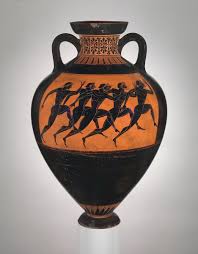
High Classical Art c. 450-400 BCE: Black Figure Pottery
Black figures/decorations on a red background
one of the main types of pottery
developed during archaic period in corinth
looking at silhouettes, less able to see the fine details that add the sense of naturalism, space, and movement
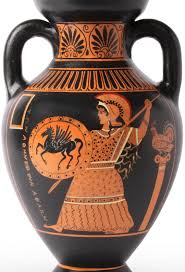
High Classical Art c. 450-400 BCE: Red Figure Pottery
Red figures on a black background
famous in athens
one of the two most popular potteries
developed during the classical period
allowed artists to paint fine details and create the illusion of 3D space and give the space a sense of movement and energy
The Late Classical Period c. 400-323 BCE: Intro
Athens defeated by sparta
Peloponnesian Wars (431 - 404 BCE)
Athens and the delian league vs sparta and the peloponnesian league
Athens was defeated in 404 BCE and lost its political and military primacy over greece
End of democracy and greek polis; replaced by the monarchical system
increased emphasis on realism
Art style shifted from the humanistic goal of expressing the ideal form of man in art to realistically portraying the indv
Moving away from idealism
The Late Classical Period c. 400-323 BCE: Naturalism vs Realism
Naturalism
Seeks to portray things in a life-like or natural manner, but no necessarily exactly as they are
Naturalistic art can be idealized
Naturalistic art is not necessarily realistic
The term describes style, not subject matter
goal: verisimilitude
Realism- seen in late classical art
Seeks to depict subjects truthfully w/o idealization
Strictly realistic cannot be idealized; its goal is to represent reality exactly as it appears, flaws and all
Realistic art is by definition naturalistic, but it’s not just naturalistic, it is also realistic
The term can be applied both to style and subject matter
Mundane things
Regular ppl doing regular stuff
Gods portrayed in a more humanizing way
subject represented truthfully
depict reality, exactly the way it is
captures the world in an authentic way
represents the world AS IT IS
therefore depicts MUNDANE things
The Late Classical Period c. 400-323 BCE: Verisimilitude
verisimilitude: the lifelike resemblance or appearance of truth that enables an artwork to convinigly represent reality
The Late Classical Period c. 400-323 BCE: Naturalism Subjects
heroic, idealized male nudes
triumphant gods and goddesses engaged in great feats
The Late Classical Period c. 400-323 BCE: Realism Subjects
regular humans doing everyday things
more humanized depictions of gods and goddesses

The Late Classical Period c. 400-323 BCE: Aphrodites of Knidos, Roman copy
new features of late classical sculpture seen in praxiteles’s aphrodite of knidos
female nudity
aphrodite is shown engaging in a mundane, everyday, very human activity— taking a bath
Powerful goddess doing a very mundane activity (taking a bath)
increasing move towards realism over idealism
done in an effort to make the gods seem more approachable to people
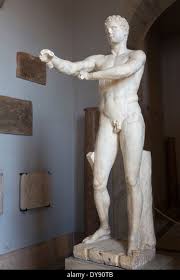
The Late Classical Period c. 400-323 BCE: Apoxyomenos (the Scraper)
by lysippos
new features of late classical sculpture seen in lysippos’s apoxyomenos
elongated body and smaller head makes the figure look taller
breaks the frontal orientation of classical greek sculpture
figure is cleaning himself off after his workout
it’s a common practice in greece to begin cleaning urself after working out by covering urself in oil and then scraping it off w a specific tool
arm extends into the view of the viewer
high classical greek sculpture was frontally oreinted, it was designed to be viewed from the front, but in the late classical period, the sculptures were appreciated by moving around
still has the contrapposto stance
nude figure
not a heroic male anymore tho

The Late Classical Period c. 400-323 BCE: Farnese Hercules
also by sculptor Lysippos
original made from bronze
later roman copy made in marble
hercules but very very tired
leaning on his club
body is drooping and tired
humanized version of hercules
details that make viewers wanna walk around the sculpture
hercules was holding apples
body is elongated and head is smaller —> makes figuer seem taller
very powerful man still showing the same weakenesses as normal ppl
realism of subject matter
The Late Classical Period c. 400-323 BCE: Architecture- Ionic
ionic
early classical period development
slender column
grace and elegance
ornate
capitals and spiral looking things
taller
there’s a base
composed of stacked base
tablature
molding, frieze, cornice
The Late Classical Period c. 400-323 BCE: Architecture- Corinthian
most decorative and elaborate
slender fluted columns
ornate column
proportions are the slimmest
always on a base
capitals with leaves
acanthus leaf
longest and most elegant
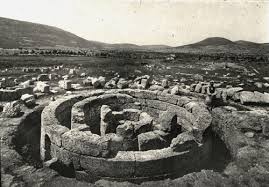
The Late Classical Period c. 400-323 BCE: Asclepius at Epidaurus
tholos
dedicated to the Goddess sclepius, who was the god of healing and medicine
4th century BCE
doric mixed with the corinthian order
plan of the building consists of 3 concentric circles
outer circle: 26 doric columns
wall behind the doric columns
very inner circle = circle of corinthian columns
biggest and most imposing structures at this sanctuary complex
The Late Classical Period c. 400-323 BCE: Asclepius at Epidaurus- Tholos
tholos: a circular building in ancient greek architecture, typically featuring a conical or domed roof and sometimes surrounded by a ring of columns (peristyle)
Hellenistic Period c. 323-31 BCE
greece defeated by Philip 2, king of Macedon, in 338 BCE
armies of philip the 2 defeated a coalition of greek city states
alexander the great ascended the throne after the assassination of his father in 336 BCE
built an empire of 2 million square miles
armies of philip = assassinated and his son Alexander AKA Alexander the great came to the throne
his empire stretched from east (india) to west (greece)
post death, his empire was divided up by his generals bc they didn’t know what else to do
antigonids
seleucids
ptolemies
Hellenistic Period c. 323-31 BCE: Antigonids
dynasty beginning with Antigonus 1, Alexander the Great’s general who took control fo macedon and a lot of greece
Hellenistic Period c. 323-31 BCE: Seleucids
founded by Sleucus 1 who dominated Syria to the Indies
one of alexander the great’s generals
Hellenistic Period c. 323-31 BCE: Ptolemies
ended up in control of egypt
Hellenistic Period c. 323-31 BCE: Info abt Art
theatricality
incorporates heightened realism
evokes an emotional response in the viewer
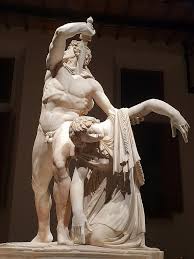
Hellenistic Period c. 323-31 BCE: Ludovisi Gaul
by the sculptor Epigonos
depicts a man from Gaul (a place in western europe) who has killed his wife and is in the act of killing himself in order to avoid being captured by foreign enemies
very dramatic movement
very strong diagonal created by his body
directs viewer’s eyes from his right foot up to his arm
his arm bends back in the opposite direction, bringing the knife towards his chest
u can see he alr stabbed himself
face of the woman
her eyes are open and staring
mouth is hanging slightly open
male’s body is rigid and all angles and straight lines but the woman’s body is limp and hanging
her body shape is defined by sort of curvilinear S shape + gentle c curve
creates sympathy in her death
even in death, there’s an elegance about her
juxtaposition abt her curvature and the harsh lines of the husband
we have to walk around the sculpture to follow the bodies
participating in the drama of the sculpture
evokes an emotional response (main goal of hellenistic art)
the male killing himself instead of fighting is a cowardly act
if he had been greek, he would’ve been brave and fought
sort of a propagandistic msg
u feel bad for the ppl in the sculpture but also feel pride for the power of their kingdom that conquers these ppl
Hellenistic Period c. 323-31 BCE: Ludovisi Gaul- Diagonal
any real or implied line, shape, or compositional arrangement that runs at an angle usually from one corner of the artwork towards the opposite side) such as from lower left to upper right.
powerful visual elements bc they create a sense of movement, energy, and dynamic tension, guiding the viewer’s eye along their direction across the composition